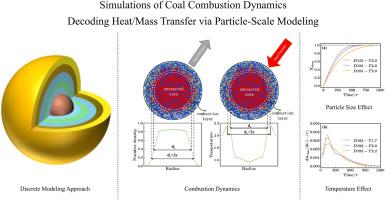Discrete simulations of combustion dynamics in coal particles: Insights into heat and mass transfer mechanisms
IF 4.3
2区 材料科学
Q2 ENGINEERING, CHEMICAL
引用次数: 0
Abstract
Coal remains a cornerstone of China's energy landscape, significantly contributing to primary energy production and consumption. This study investigates the combustion characteristics of coal particles using a discrete modeling approach to simulate the combustion behavior of single particles. The research reveals that larger particle sizes increase heat and mass transfer resistance, prolonging combustion duration, while higher ambient temperatures enhance convective heat transfer, accelerating combustion reactions. Additionally, the spatial distribution of inert cohesive beads significantly affects gas diffusion, with certain arrangements hindering gas release. The model is validated against current literature, demonstrating its capability to predict carbon conversion rates and combustion dynamics. These findings provide valuable insights into coal combustion mechanisms, offering a foundation for optimizing combustion processes and improving energy efficiency while addressing environmental concerns.

煤颗粒燃烧动力学的离散模拟:对传热传质机制的洞察
煤炭仍然是中国能源格局的基石,在一次能源生产和消费中发挥着重要作用。本研究采用离散建模方法模拟单颗粒的燃烧行为,研究了煤颗粒的燃烧特性。研究表明,颗粒尺寸越大,传热传质阻力增大,燃烧持续时间延长,而环境温度越高,对流换热增强,燃烧反应加速。此外,惰性内聚微珠的空间分布显著影响气体扩散,某些排列阻碍气体释放。根据现有文献验证了该模型,证明了其预测碳转化率和燃烧动力学的能力。这些发现为煤的燃烧机制提供了有价值的见解,为优化燃烧过程和提高能源效率提供了基础,同时解决了环境问题。
本文章由计算机程序翻译,如有差异,请以英文原文为准。
求助全文
约1分钟内获得全文
求助全文
来源期刊

Particuology
工程技术-材料科学:综合
CiteScore
6.70
自引率
2.90%
发文量
1730
审稿时长
32 days
期刊介绍:
The word ‘particuology’ was coined to parallel the discipline for the science and technology of particles.
Particuology is an interdisciplinary journal that publishes frontier research articles and critical reviews on the discovery, formulation and engineering of particulate materials, processes and systems. It especially welcomes contributions utilising advanced theoretical, modelling and measurement methods to enable the discovery and creation of new particulate materials, and the manufacturing of functional particulate-based products, such as sensors.
Papers are handled by Thematic Editors who oversee contributions from specific subject fields. These fields are classified into: Particle Synthesis and Modification; Particle Characterization and Measurement; Granular Systems and Bulk Solids Technology; Fluidization and Particle-Fluid Systems; Aerosols; and Applications of Particle Technology.
Key topics concerning the creation and processing of particulates include:
-Modelling and simulation of particle formation, collective behaviour of particles and systems for particle production over a broad spectrum of length scales
-Mining of experimental data for particle synthesis and surface properties to facilitate the creation of new materials and processes
-Particle design and preparation including controlled response and sensing functionalities in formation, delivery systems and biological systems, etc.
-Experimental and computational methods for visualization and analysis of particulate system.
These topics are broadly relevant to the production of materials, pharmaceuticals and food, and to the conversion of energy resources to fuels and protection of the environment.
 求助内容:
求助内容: 应助结果提醒方式:
应助结果提醒方式:


